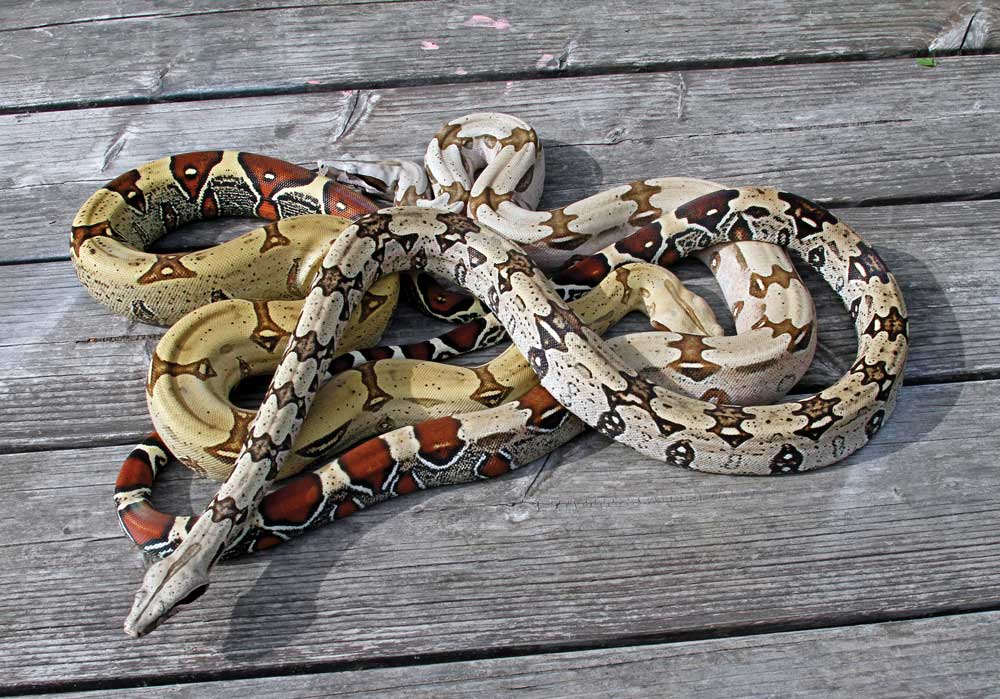With beautiful colors and markings, impressive musculature, and alluring behavior, true red-tailed boas (Boa constrictor constrictor, or “Bcc”) are on
With beautiful colors and markings, impressive musculature, and alluring behavior, true red-tailed boas (Boa constrictor constrictor, or “Bcc”) are one of the most esteemed reptiles in captivity. However, their husbandry can be challenging, especially for beginners. After keeping a variety of different reptiles, I decided to focus specifically on red-tailed and other locality boas about 20 years ago. As a Bcc beginner, I was guided by information in books and through experiences of other keepers shared online, much of it wrong and/or irrelevant to my situation. I made mistakes, saw what worked, and refined my husbandry and procedures over the years, leading to repeated successful breeding of several different types of Bcc. Here, I want to share my experience to provide a foundation for successful keeping and breeding of true red tails, as well as tips and tricks that have increased my overall success.
What is a “True” Red-Tailed Boa?
Boa constrictor constrictor are large snakes, although their typical size is often misunderstood. Most captive adults are in the 6- to 8-foot range. Much larger specimens exist, with a maximum size of about 13 to 14 feet; however, specimens over 10 feet are rare. Females tend to be a foot or so longer than males. Markings on these snakes consist of 14 to 22 saddles of dark pigment over a lighter background color.
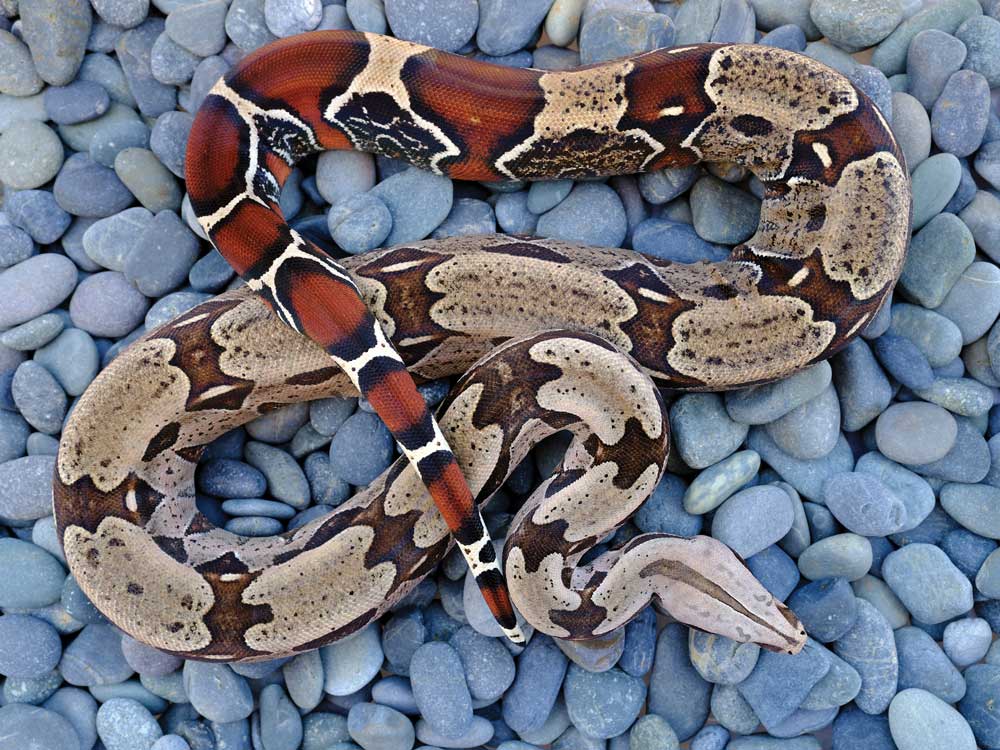
Surinamese Bcc are the epitome of true red-tailed boas for many keepers. Photo by Brian Vuillemenot
Some Bcc have a pointed extension on both sides of each saddle, known as “peaked” saddles (because the saddle resembles a widow’s peak). Saddles become oval toward the tail and the color of tail saddles ranges from bright fire engine red to dark blood red to maroon. Red tails typically have distinct head markings, known as “eyelashes,” and a wedge-shaped head with a pointed snout. The body is typically very muscular, square, and laterally flattened.
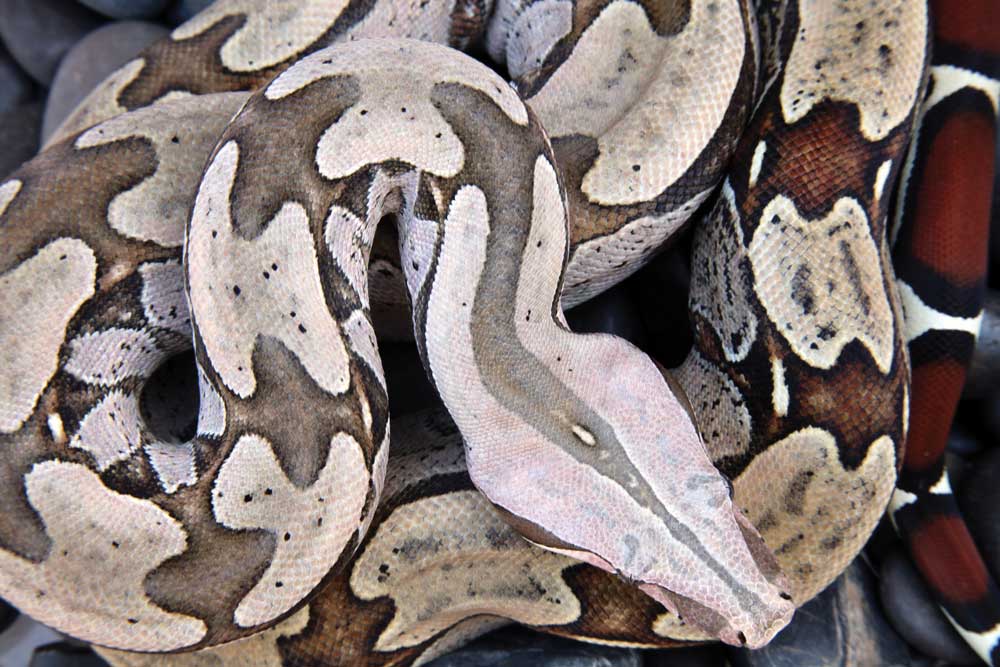
True red-tailed boas have a distinct wedge shaped head and pointy snout, often with “eyelash” markings. Above is a captive bred Surinamese specimen with particularly symmetrical peaked saddles. Photo by Brian Vuillemenot
Although all true red tails are of the same subspecies, there is considerable physical variation in appearance over the geographic range. Boa constrictor enthusiasts often designate animals by their specific location of origin, typically defined by South American country. Since the vast majority of Bcc in the reptile hobby today are captive bred, often several generations removed from the wild caught breeding stock, careful and accurate documentation of each generation is critical to support locality claims. In the absence of documentation, no definitive locality identification can be made from physical description alone.
However, different Bcc localities are known for specific physical characteristics. For example, those from Suriname typically have long, bright red tails and a pinkish tan to buckskin body coloration, often with peaked saddles. Those from Peru often will have a lemon yellow to golden brown coloration, typically with round saddles, while the variety from northern Brazil is known for asymmetrical peaked saddles on a greyish yellow background with speckles and other background markings.
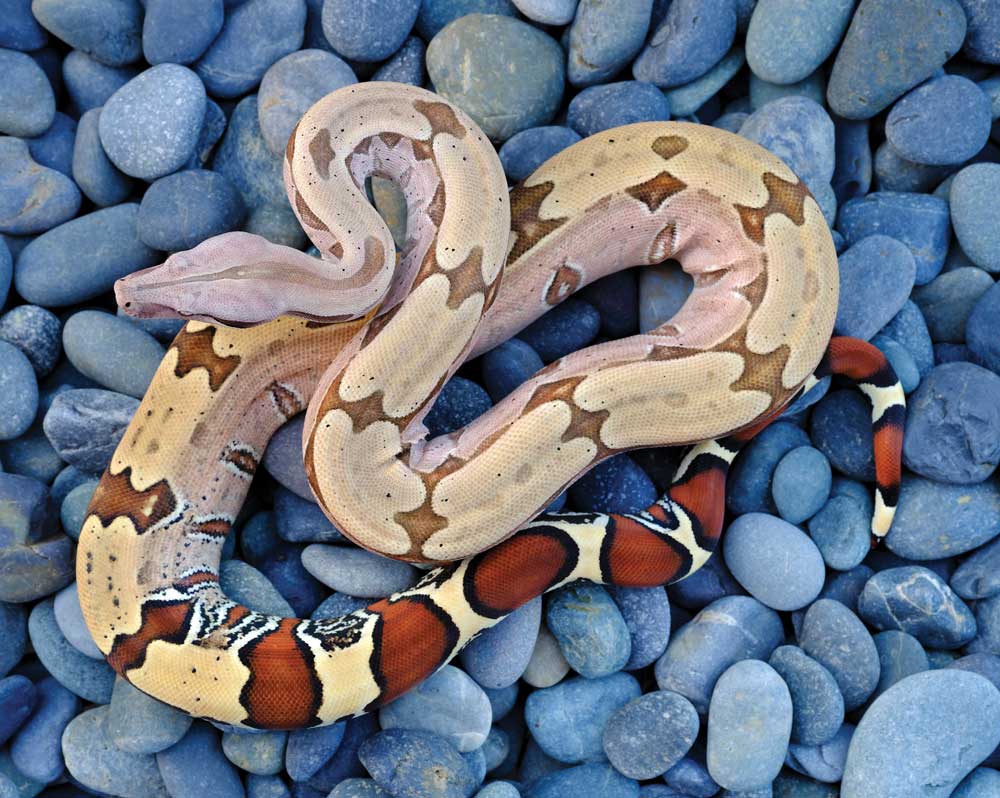
Surinamese Bcc. Photo by Brian Vuillemenot
However, there are many boas originating from a verified locality without a typical appearance for that locale. In addition, selective breeding for desired characteristics has amplified naturally occurring physical differences. Considerable debate exists among red- tailed enthusiasts about the legitimacy of certain localities, such as whether the animals from Guyana are phenotypically distinct from Surinamese specimens.
There is much confusion surrounding the term “red-tailed boa.” After all, isn’t any boa with a red tail a red-tailed boa? This has led to the emergence of a related term, “true red-tailed boa.” Strictly speaking, a “true” red-tailed boa is of the species Boa constrictor constrictor, occupying a large range in South America east of the Andes, from the Guyana Shield through the Amazon rainforest.
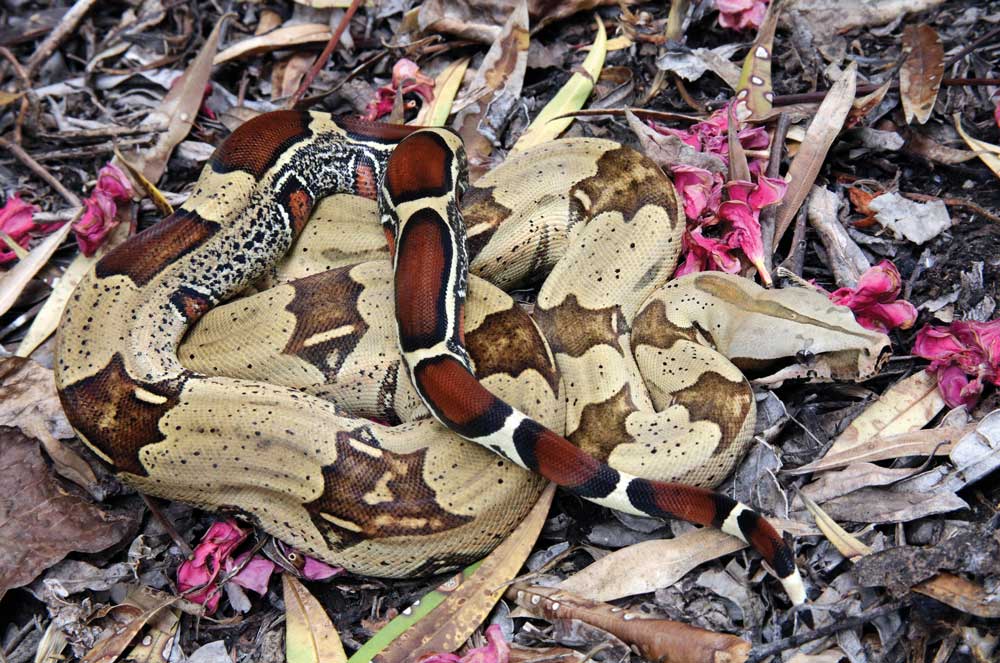
Bcc from Peru are known for golden yellow body color and bright red tails. A farm bred specimen from Iquitos. Photo by Brian Vuillemenot
Many boas in the pet trade, which may have red tails, are a different species, Boa imperator, ranging from Mexico through Central America and into Colombia. The type from Colombia, often referred to as a “Colombian red tail,” is particularly often confused with “true” red tails. In comparison, Colombian Boa imperator have a different head and body shape, higher saddle count, and tail that tends to be more of a rusty brownish red. For this reason, using scientific names with accurate locality information is the best way to identify your pet boa. Although physical differences may be subtle, by studying photographs of true red tails and other boas available online and in books you will soon learn what to look for to differentiate the two.
Housing Red-tailed Boa Constrictors
Red tails generally do well in PVC snake cages available commercially. The length and width of the cage should be equal to or greater than the length of the snake, so a cage with a 4’ x 2’ foot floor area could accommodate a boa up to 6 feet. However, it is preferable to have a cage as long as the boa. For most adults, a cage with a 6’ x 2’ foot floor area that is 18 to 24 inches high, will work well. The largest animals require an 8-foot enclosure. It is also possible to build your own boa enclosures from a variety of materials. I use rack systems to maintain baby and subadult boas. Adult boas will require the larger enclosures.
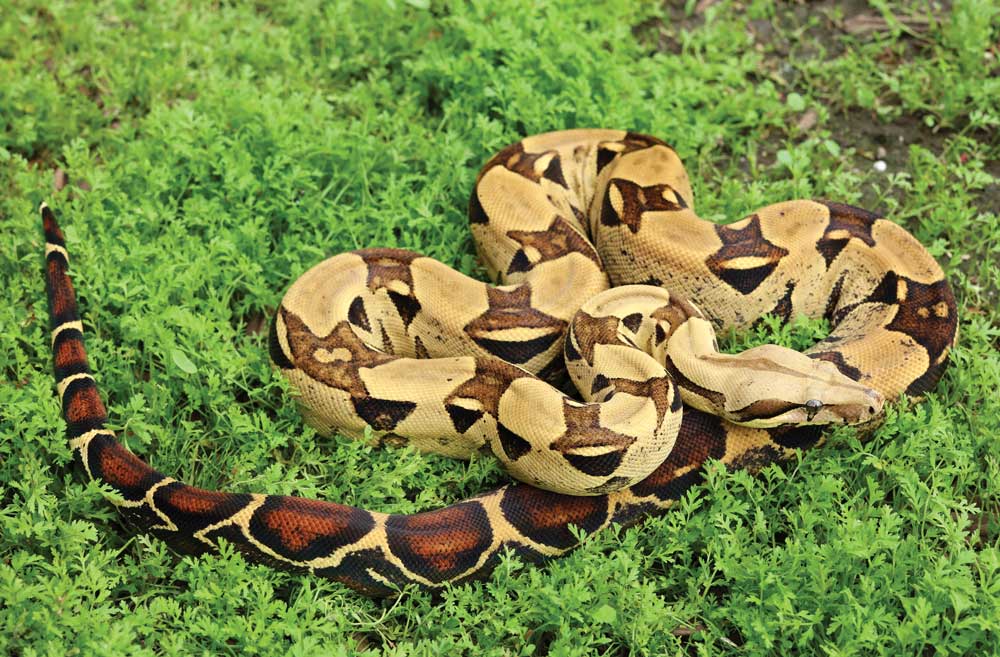
Locality specific Bcc from Venezuela. Photo by Brian Vuillemenot
A suitable substrate should line the bottom of the enclosure. Several options exist, each with pros and cons; there is no one perfect substrate for all situations. Coconut coir works well for most of my boas, providing a nice-looking, long-lasting, substrate that maintains high humidity and boa comfort. However, I typically use paper towels for baby boas in rack systems and newspaper in situations where frequent changes are needed.
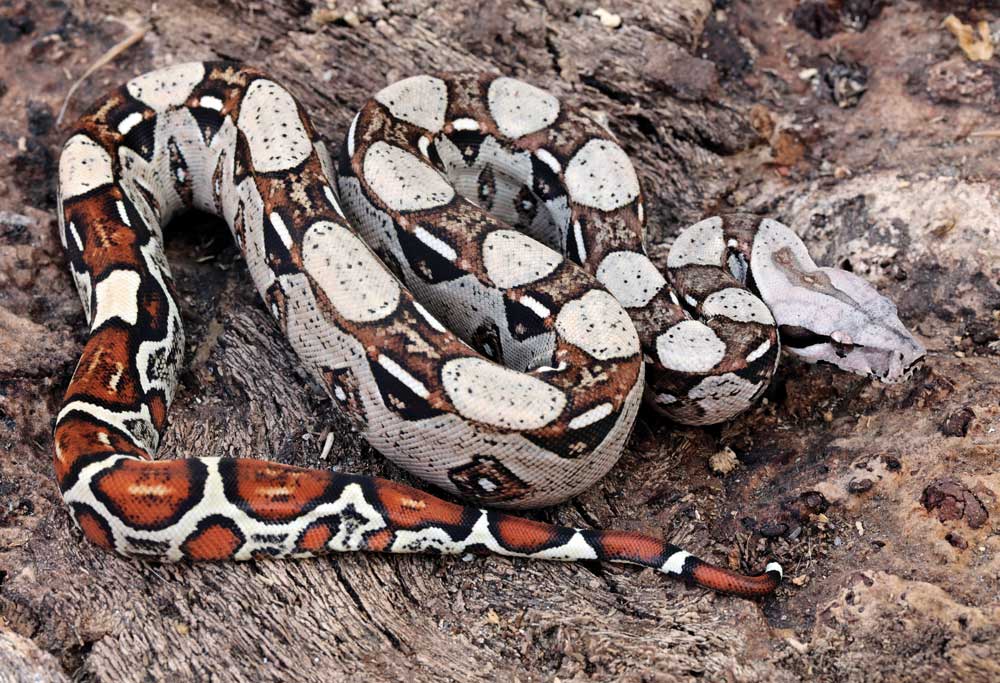
Boa imperator from Colombia are not true red tails but can be just as beautiful. A locality specific specimen from Barranquilla. Photo by Brian Vuillemenot
Bcc in my collection thrive with a hot spot of 88 to 90 degrees Fahrenheit (31.1 to 32.2 degrees Celsius) covering about 25% of the bottom of the enclosure. The cool side stays at 75 to 80 degrees Fahrenheit (23.9 to 26.7 degrees Celsius), about 5 degrees above ambient room temperature. I use Flexwatt or similar heat tape/mats as the sole heat source in most enclosures. A few larger enclosures have a heat emitting panel installed in the ceiling on one side. A reptile thermostat maintains the hot spot temperature, and the cool side automatically falls in the correct range given the ambient temperatures in my snake rooms. Humidity is kept at 60-70% with room humidifiers and by misting the substate. At least two hiding places are provided in each enclosure (on the hot spot and cool side), as well as climbing branches and an 8-inch plastic water bowl. No special lighting is used other than ambient fluorescent room lights and natural light entering through windows.
Feeding Boa constrictor constrictor
In the wild, red tails eat a variety of prey, including mammals, birds, and lizards. In captivity, they typically feed with gusto on mice, rats, rabbits, chickens, and quail. I start neonates on live hopper mice shortly after their first shed at about 2 weeks of age. They transition to frozen thawed mice within a few feedings, although some newborns eat frozen thawed from their first meal. Rodent size is increased as the boa grows. An appropriately sized meal leaves a barely noticeable bulge. Most subadults eat full grown mice by a year of age and then transition to rats of appropriate size. When approaching maturity at 4 to 5 years of age, most red tails eat large to extra large rats. Quail and chickens are eaten enthusiastically and provide nutritional variety. The vast majority of red tails eat thawed frozen prey without difficulty.

When approaching maturity at 4 to 5 years of age, most red tails eat large to extra large rats. Quail and chickens are eaten enthusiastically and provide nutritional variety.
True red tails grow slower than many other snakes and should be fed less often. In general, a meal should be offered every 10-14 days for the first few years and then the feeding interval decreased to once every 2-3 weeks. Adults should be fed often enough to maintain a lean, muscular, but not thin, body condition. Starting the second winter, food is withheld for 1.5 to 2 months to cycle for breeding. If Bcc eat too frequently, or too large of a food item, regurgitation of a partially digested meal may occur three to four days post feeding. In this event, most frequently encountered in animals under a year old, food should be withheld for 3-4 weeks, and then a smaller than normal food item offered.
It is important to check the enclosure temperatures to make sure the hot spot is not too hot or cold, the main cause of regurgitation. Handling should also be kept to a minimum to reduce the chances of a second regurgitation. If a second regurgitation occurs, it becomes difficult to stop the cycle; this is the most common reason that baby Bcc die in captivity. When selecting a Bcc, especially your first, ask the seller about its feeding history. Also, acquiring an older animal may reduce the chances of regurgitation.
Breeding True Red-tailed Boas
Bcc are challenging to reproduce in captivity. There is no set formula that works in all situations, and success is equal parts art and science. Many breeders are successful using a strategy similar to the one I use, described here. Male Bcc are at least four years old, and females five, before breeding. Most animals are 5 to 7 feet long at this age. The most effective way to acquire well prepared breeding stock is to obtain high quality captive bred offspring from a reputable breeder and raise the animals to maturity with optimal care.
Although a long time is needed to raise a baby boa to breeding age, a higher success rate is likely compared to starting with adults.
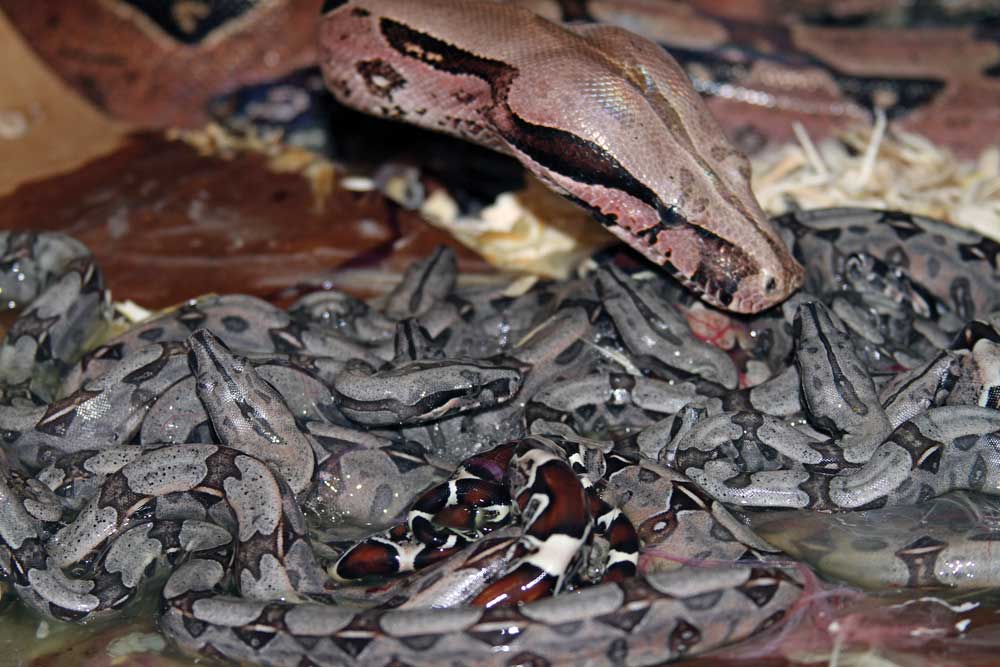
There is no better sight than entering the snake room to see a healthy litter of baby red tails! This is the reward for many years of work and planning.
Photo by Brian Vuillemenot
Many breeders use environmental cycling to induce breeding. Temperatures are typically dropped by 10 to 20 degrees Fahrenheit (-12.2 to -6.7 degrees Celsius), starting in November or December, for 24 hours a day or at night only. Temperature drops are maintained for 1.5 to 2.5 months before and/or during the start of the breeding trials. The temperature is decreased gradually over several weeks until the full drop is reached. A reptile thermostat which can be programed with a nightly temperature drop is very useful to accomplish cycling. While some breeders wait until the full temperature drop is reached, I usually pair up breeders at the start of cycling to allow for the maximum period for breeding to occur. Some breeders reduce the photoperiod at this time, and/or alter the humidity. Other successful Bcc breeders do not provide any temperature or environmental changes.
The last meal for the year is given two weeks before starting cycling, typically mid-October to early November. Since males may be reluctant breeders, pairs are introduced by placing the female in the male’s enclosure. Breeding activity may start immediately, with the male aligning with the female and wrapping tails to copulate. Other times, little or no breeding activity is observed. Predicting successful pairings can be difficult, as even well-matched animals in optimal condition may show no interest in breeding. Other animals will start to copulate shortly after introduction and mate constantly for several months. It is likely that there are compatibility issues with certain male-female pairs that are imperceptible to the breeder.
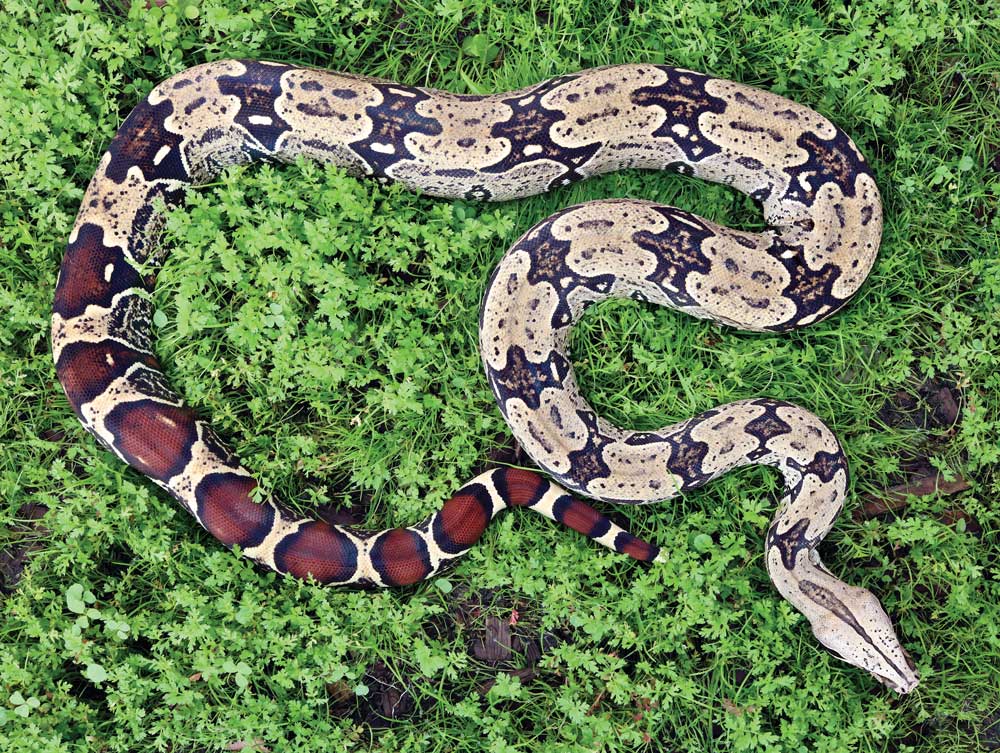
Locality specific Bcc North Brazil. Photo by Brian Vuillemenot
Most Bcc breeders pair up one male and female. Lack of successful breeding is often because the male shows no interest. To address this, more than one male may be paired with each female either in succession or simultaneously.
The presence of a second male may induce the reluctant male to breed more vigorously. In addition, use of two males provides a backup in case of infertility or incompatibility with the female. A shed skin from a second male boa placed in the breeding enclosure with the reluctant male may have a similar effect as an actual male and will eliminate uncertainty as to the parentage of the resulting litter. Other tricks to include reluctant animals to breed include misting the enclosure and pairing up in stormy weather during a drop in barometric pressure. Using multiple females with a single male is unlikely to result in success and is not recommended.
Temperature cycling is maintained for about two months through January or February, after which temperatures are gradually increased to normal. At this point, I separate pairs for about a week, and offer food.
Animals are then paired back up for three to four weeks, followed by a one-week separation for feeding, repeated until the female is gravid or the end of breeding trials in late spring. Most animals will feed during breeding trials. Because of the long duration and large energy expenditure a female puts into breeding, I feed gravid females until about 45 days before their due date.
Ovulation in females typically occurs several months after the start of breeding trials, and abdominal swelling may be observed. Females will then usually (but not always) enter a shed cycle lasting approximately 10 days and shed about two weeks after ovulation (the post ovulation shed, or POS). Once gravid, a female’s coloration may darken and she will typically coil motionless above the hotspot and maintain a high body temperature, typically 86 to 89 degrees Fahrenheit (30.0 to 31.7 degrees Celsius). It is important to monitor the hot spot temperature (88 to 90 degrees Fahrenheit or 31.1 to 32.2 degrees Celsius) to provide optimal conditions for the development of the babies. The male will typically lose interest in mating when the female is gravid.
I keep pairs together until I am sure the female is gravid, or until early June if not appearing gravid, at which time breeding trials end. About one-half to two-thirds of my Bcc breeding trials result in gravid females. Females that did not become gravid are often paired up the following year with a different male.
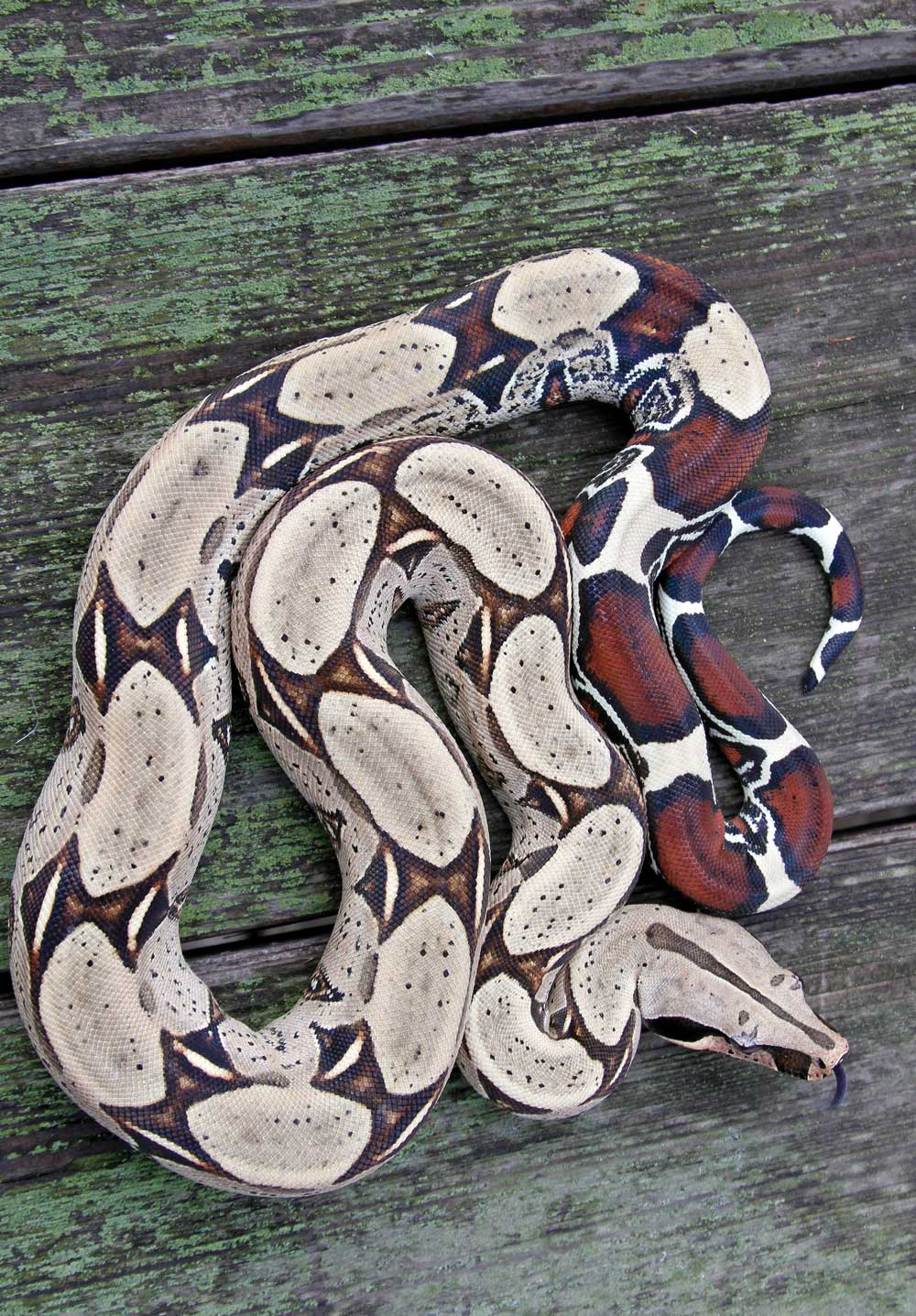
A Peruvian red tail with particularly well formed, “bowtie” shaped saddles.
Baby Bcc are typically born 105-115 days after the POS, or 120-130 days post ovulation. Several days before birth, the female will typically start to move and explore the cage, looking for a suitable nesting site. In addition, she may pass an abnormally colored “waxy” stool, often yellow to green in color with a plastic appearance. On the day of birth, the mother will line up her body with the side of the cage and contract her abdomen to expel the babies through her cloaca.
Birth takes from a few minutes to several hours. Unfertilized ova, known as slugs, are often present. There may also be stillborn and/or malformed young. Birth often takes place at night or early morning, so a breeder may not witness the process and may discover the birth when a baby boa is observed. Litter sizes can range from 1 to over 60, but a typical size litter is 12 or 15 neonates.
After birth is complete, mother and babies are removed from the enclosure. Protective mothers may act defensively after birth, so they should be gently restrained and moved to a separate container. The mother is soaked in lukewarm water for 30 to 60 minutes after birth to clean her up and remove traces of the birthing process. While soaking, babies are inventoried and the mother’s enclosure thoroughly cleaned. Mother boas are fed a smaller than normal sized meal the day after birth, and then a typically sized meal a week later.
Depending on body condition, mother boas are often fed an accelerated feeding schedule for a few months after birth to allow recovery to a healthy body condition. I strongly recommend against breeding females more often than every other year since it can take many months to recover from producing a litter.
Neonate Bcc are communally housed in plastic tubs for 10 days or so, until shedding. A paper towel substrate is used with crumpled paper towels for hiding places, misted to maintain high humidity.
A heat mat under one half of the tub is thermostatically controlled to provide a temperature of 88 to 90 degrees Fahrenheit (31.1 to 32.2 degrees Celsius), with the other half at the ambient room temperature of about 75 degrees Fahrenheit (23.9 degrees Celsius) and humidity of approximately 80%.
Most baby Bcc shed at about 10 days of age and are then moved to individual 16-quart tubs in a rack system with a paper towel substrate, hiding places, and water dish. A live fuzzy mouse is typically offered for the first meal shortly afterwards. Some Bcc will accept thawed frozen prey items as their first meals and almost all will after a few live meals. Baby red tails are fed every two weeks; more frequent feeding may result in regurgitation, as described above. When animals are two months old and well established, they are ready to begin life in their new homes.
Conclusion
True red-tailed boas are one of the most impressive and rewarding species of snake to keep but can be less forgiving of sub-optimal husbandry than many other reptiles. Diligence in providing optimal environmental conditions and careful attention to diet will greatly increase success. Producing a healthy litter of Bcc neonates is an extremely rewarding achievement and usually results only from many years of hard work, persistence, and attention to the husbandry needs of your snake.
With an advanced degree in molecular biology, Brian Vuillemenot brings a scientific approach to his work with reptiles. He specializes in keeping and breeding true red tail, dwarf island, and other locality boas. Vuillemenot lives in northern California with his animals and human family. For more information on keeping and breeding true red tails and other boa constrictors, you can watch his YouTube channel, Brian Boas, and follow him on Facebook (Brian Boas) and Instagram (vuillemenboa).

